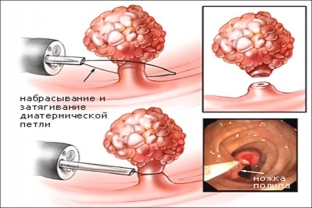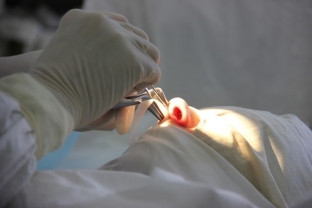Surgical treatment of nasal polyps is indicated for patients who have impaired nasal breathing, this is accompanied by olfactory disorders, frequent attacks of bronchial asthma, snoring, often recurrent sinusitis, deviated nasal septum. If polyps are detected during an exacerbation of a chronic disease, surgical treatment is postponed until a stable remission occurs. There are several methods of surgical treatment of polyps in the nose, they all differ in the technique of execution, the level of trauma and the degree of effectiveness.
Treatment of nasal polyps with a polyposis loop
Nasal polyps are often treated with a polyposis loop and other surgical instruments. The disadvantage of this method is that in this way it is possible to remove only those polyps that are in the nasal cavity. Polyps in most cases grow from the paranasal sinuses, the polypous tissue remaining in the sinuses grows again and forms new polyps. After this method of surgical treatment of nasal polyps, they recur during the first two years after surgery. In addition, the method is traumatic and is accompanied by profuse bleeding.

The effectiveness of modern methods of treatment of nasal polyps
There is a method of less traumatic and bloodless removal of polyps in the nose. This laser method. This type of surgery is performed under local anesthesia on an outpatient basis. Such surgical treatment of polyps in the nose is as sterile as possible and minimally painful. The patient fully recovers after the removal of polyps within 3-4 days after the operation.
The most modern and effective treatment for nasal polyps is their endoscopic removal. Such an operation is accompanied by endovideosurgical visualization, polyps are removed using a special power tool. The tool draws the polyp into the opening of its tip, shaving it off at the base. The later occurrence of relapses is due to the high accuracy of the instrument and good visualization during the operation. Also, the surgeon can correct the anatomical architecture of the nose during the operation in order to improve the drainage of the paranasal sinuses. Thus, all conditions have been created for the shortest and most effective postoperative period, as well as the improvement of subsequent operations in order to treat nasal polyps.

Importance of anti-relapse treatment of nasal polyps
After removal of polyps, they can recur and often grow back. Therefore, after the surgical removal of polyps in the nose, anti-relapse treatment is carried out. The field of operation for 10 days, you need to take care of the nasal cavity - washing the nose with saline or irrigation with sprays. Corticosteroid therapy is also prescribed for 3 months in the form of inhalations with a certain dose for irrigation of the nasal cavity. This use of glucocorticosteroids does not have a systemic effect.
Patients after surgical treatment of nasal polyps should be observed by an otolaryngologist for at least 1 year after surgery, visiting the doctor every 3 months.
Polyps in the nose are not life threatening. If polyps are not removed on time, they can provoke the development of anosmia, which will not go away after surgical treatment of polyps in the nose. It is extremely important to identify and eliminate polyps in childhood, because polyps disrupt the formation of the facial skeleton and dentition.
Unfortunately, after removal of polyps, they recur. It is considered a good prognostic sign if the polyp recurs no earlier than 6-7 years after surgery.







Add a comment